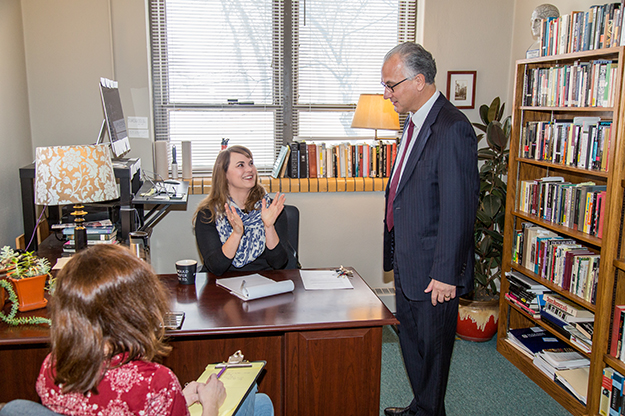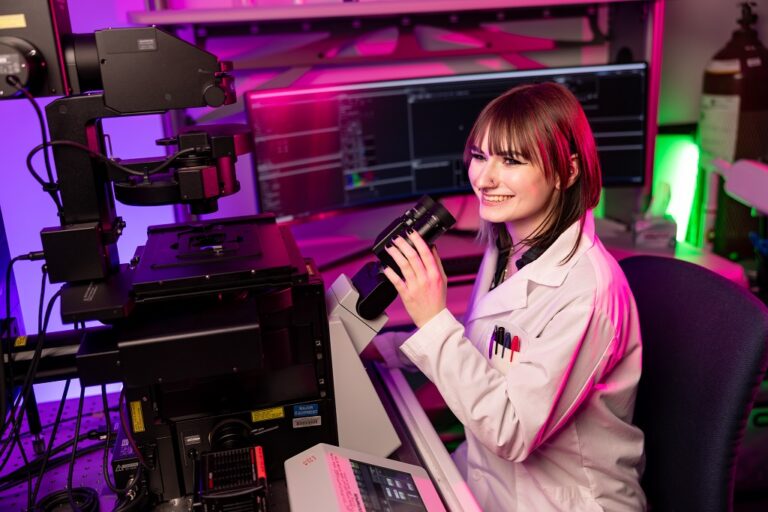Digital distinction
UND Assistant Professor Sheila Liming surprised with state grant, recognizing her innovative use of technology in the English classroom

Monday morning brought waves of confusion, surprise and joy for Assistant Professor of English Sheila Liming when UND President Mark Kennedy walked through her office door.
Kennedy’s unexpected visit was to present Liming with a North Dakota University System (NDUS) award for technology use in the classroom.
“I’m going to say ‘wow’ a lot. I’m going to keep saying it,” Liming smiled, as she shook the president’s hand.
The $500 NDUS commendatory grant is awarded every year to a faculty member in higher education to recognize “use of technology in the delivery of instruction.” One of these awards is given to UND every year, and the recipient is determined by a nomination process among faculty members. This year, Liming’s name was among UND’s nominees, and her modernization of the English curriculum made her the top pick of the University Senate Executive Committee.
“She’s been an innovative user of technology in the classroom,” said UND English chair Eric Wolfe. “Digital humanities is one of her areas of expertise, so I think her students have really appreciated the skills that she has helped them build, and I think that will help them in the careers that they go into after UND.”
Kennedy said he believes recognitions like this are vitally important because technology education is demanded more and more by students in their educational process.
“This $500 award gives some latitude to continue to move technology in the classroom forward, some encouragement to do so,” Kennedy said. “But I think we want more than just Sheila to be adapting it; we want all to be adapting it. When you reach out and reward certain advancements, that’s a signal across campus to say this is a good thing — this is something we all ought to be doing.”

Technology and texts
Those who nominated Liming for the commendatory grant provided a seemingly unending list of the ways she provides a digital education for her students. One of those learning elements is the use of course blogs. Liming uses the blog platform to open up conversation and feedback between students and encourage them to take an active role in shaping the course itself.
“We may have an idea of what an English curriculum is — reading Shakespeare and Chaucer and those things — but in reality, look at where you apply it,” Kennedy said. “Organizations are looking for employees who can write a crisp response to a complex issue through a blog or social media. I think incorporating this technology into an English class will give the full range of skills that you would expect an English class to provide.”
Liming was also applauded for using Adobe Creative Suite for assignments, accessing digital archives and scholarly journals in class lectures and assignments, utilizing digital exhibition platforms to showcase student work and more. In just one Digital Humanities class this semester, students redesigned book covers with Photoshop, tagged metadata, uploaded files into a digital archive and built their own websites.
“I try to incorporate digital technology into every class I teach, whether or not the class itself is oriented around that as a topic or specifically as a method.” Liming said. “As English scholars and students we deal with text a lot — that’s primarily what we do — and the vast amount of text is now digital. So the majority of ways we interact with it, whether it’s through libraries, or what we read online as news, or even literature and e-books — most of what we work with, we work with in digital platforms and through digital environments.”
Grant at work
Liming already has some ideas about how she can use the commendatory grant to advance her research and create a new learning experience for students. She’s in the process of building an electronic database of all of the books contained in writer Edith Wharton’s library.
“She left behind a library of over 2,700 books in which she wrote in the margins,” Liming explained. “What we’re doing is scanning her entire library collection so that scholars will be able to have free access to this database and see what books she owned, who she was reading and what she was thinking about.”
A project of this size requires people, and Liming hopes to use her grant to hire student research assistants to help in building the website and uploading the necessary files.
“When the site is complete, we’re going to move it to a public domain to launch it to the public,” she said. “This grant moves me to that goal much faster.”


